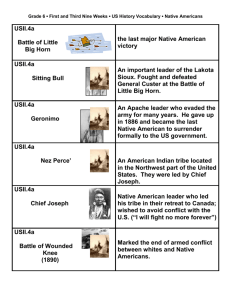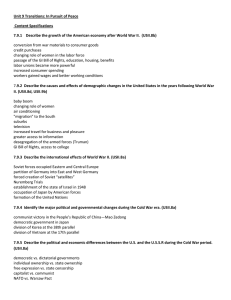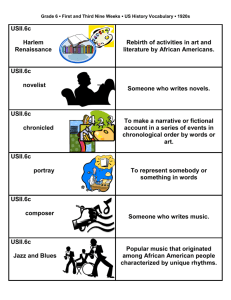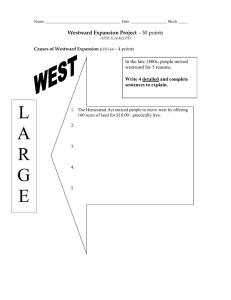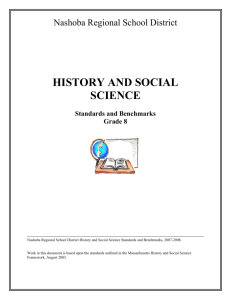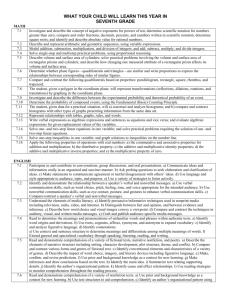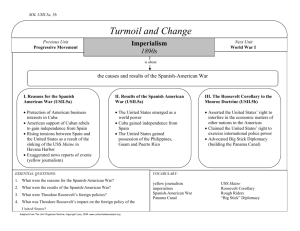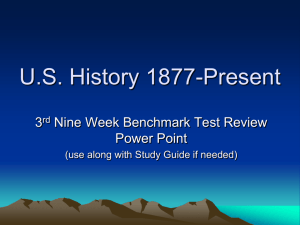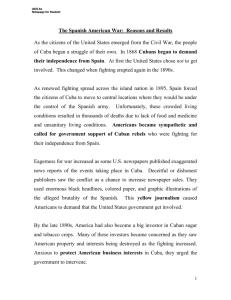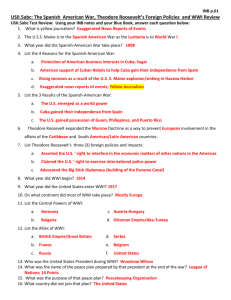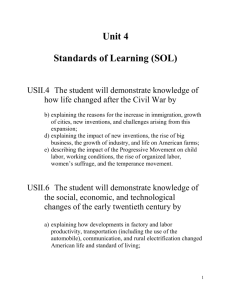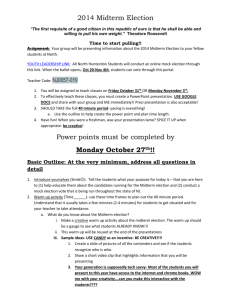US History II.doc
advertisement
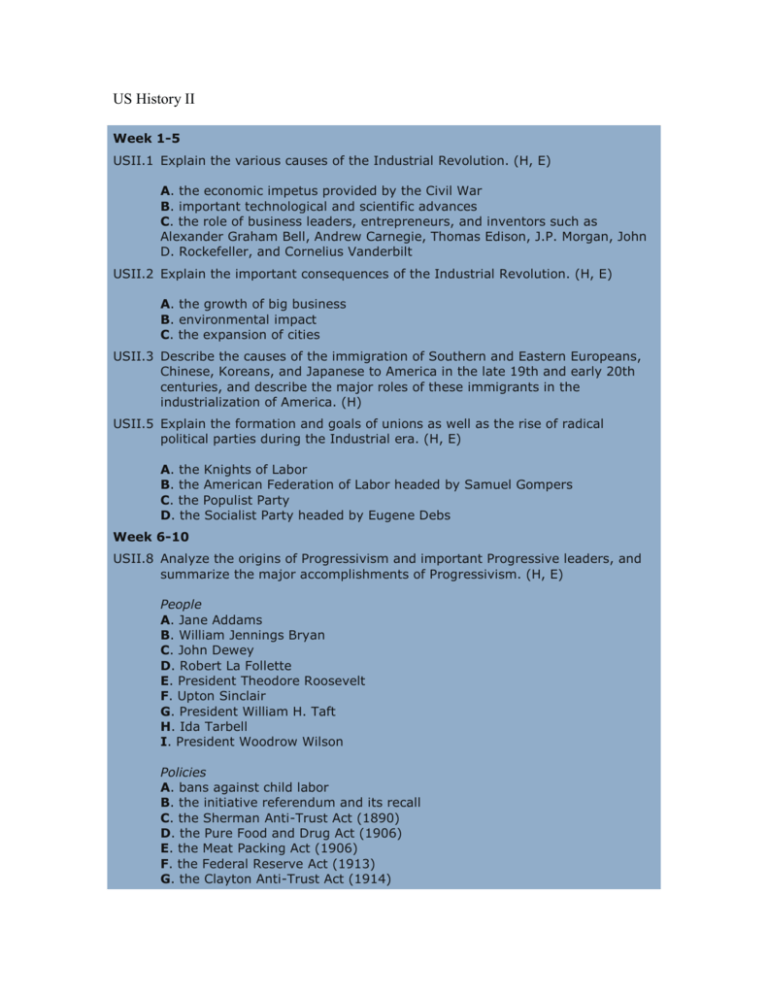
US History II Week 1-5 USII.1 Explain the various causes of the Industrial Revolution. (H, E) A. the economic impetus provided by the Civil War B. important technological and scientific advances C. the role of business leaders, entrepreneurs, and inventors such as Alexander Graham Bell, Andrew Carnegie, Thomas Edison, J.P. Morgan, John D. Rockefeller, and Cornelius Vanderbilt USII.2 Explain the important consequences of the Industrial Revolution. (H, E) A. the growth of big business B. environmental impact C. the expansion of cities USII.3 Describe the causes of the immigration of Southern and Eastern Europeans, Chinese, Koreans, and Japanese to America in the late 19th and early 20th centuries, and describe the major roles of these immigrants in the industrialization of America. (H) USII.5 Explain the formation and goals of unions as well as the rise of radical political parties during the Industrial era. (H, E) A. the Knights of Labor B. the American Federation of Labor headed by Samuel Gompers C. the Populist Party D. the Socialist Party headed by Eugene Debs Week 6-10 USII.8 Analyze the origins of Progressivism and important Progressive leaders, and summarize the major accomplishments of Progressivism. (H, E) People A. Jane Addams B. William Jennings Bryan C. John Dewey D. Robert La Follette E. President Theodore Roosevelt F. Upton Sinclair G. President William H. Taft H. Ida Tarbell I. President Woodrow Wilson Policies A. bans against child labor B. the initiative referendum and its recall C. the Sherman Anti-Trust Act (1890) D. the Pure Food and Drug Act (1906) E. the Meat Packing Act (1906) F. the Federal Reserve Act (1913) G. the Clayton Anti-Trust Act (1914) H. the ratification of the Nineteenth Amendment in 1920 USII.9 Analyze the post-Civil War struggles of African Americans and women to gain basic civil rights. (H) A. Carrie Chapman Catt B. W.E.B. Du Bois C. Marcus Garvey D. the National Association for the Advancement of Colored People (NAACP) E. Alice Paul F. Booker T. Washington Week 11-15 USII.4 Analyze the causes of the continuing westward expansion of the American people after the Civil War and the impact of this migration on the Indians. (H) USII.6 Analyze the causes and course of America’s growing role in world affairs from the Civil War to World War I. (H, E) A. the influence of the ideas associated with Social Darwinism B. the purchase of Alaska from Russia C. America’s growing influence in Hawaii leading to annexation D. the Spanish-American War E. U.S. expansion into Asia under the Open Door policy F. President Roosevelt’s Corollary to the Monroe Doctrine G. America’s role in the building of the Panama Canal H. President Taft’s Dollar Diplomacy I. President Wilson’s intervention in Mexico Week 16-20 USII.6 Analyze the causes and course of America’s growing role in world affairs from the Civil War to World War I. (H, E) J. American entry into World War I USII.7 Explain the course and significance of President Wilson’s wartime diplomacy, including his Fourteen Points, the League of Nations, and the failure of the Versailles treaty. (H) USII.10 Describe how the battle between traditionalism and modernity manifested itself in the major historical trends and events after World War I and throughout the 1920s. (H) A. the Boston police strike in 1919 B. the Red Scare and Sacco and Vanzetti C. racial and ethnic tensions D. the Scopes Trial and the debate over Darwin’s On the Origins of Species E. Prohibition Week 21-25 USII.11 Describe the various causes and consequences of the global depression of the 1930s, and analyze how Americans responded to the Great Depression. (H, E) A. restrictive monetary policies B. unemployment C. support for political and economic reform D. the influence of the ideas of John Maynard Keynes, and the critique of centralized economic planning and management by Ludwig von Mises, Friedrich von Hayek, and Milton Friedman USII.12 Analyze the important policies, institutions, and personalities of the New Deal era. (H) People A. President Herbert Hoover B. President Franklin D. Roosevelt C. Eleanor Roosevelt D. Huey Long E. Charles Coughlin Policies, the establishment of A. the Federal Deposit Insurance Corporation B. the Securities and Exchange Commission C. the Tennessee Valley Authority D. the Social Security Act, the National Labor Relations Act E. the Works Progress Administration F. the Fair Labor Standards Act Institutions A. the American Federation of Labor B. the Congress of Industrial Organizations C. the American Communist Party USII.13 Explain how the Great Depression and the New Deal affected American society. (H) A. the increased importance of the federal government in establishing economic and social policies B. the emergence of a "New Deal coalition" consisting of African Americans, blue-collar workers, poor farmers, Jews, and Catholics USII.14 Explain the strength of American isolationism after World War I and analyze its impact on U.S. foreign policy. (H) USII.15 Analyze how German aggression in Europe and Japanese aggression in Asia contributed to the start of World War II and summarize the major battles and events of the war. On a map of the world, locate the Allied powers (Britain, France, the Soviet Union, and the United States) and Axis powers (Germany, Italy, and Japan). (H) A. Fascism in Germany and Italy B. German rearmament and militarization of the Rhineland C. Germany’s seizure of Austria and Czechoslovakia and Germany’s invasion of Poland D. Japan’s invasion of China and the Rape of Nanking E. Pearl Harbor, Midway, D-Day, Okinawa, the Battle of the Bulge, Iwo Jima, and the Yalta and Potsdam conferences USII.16 Explain the reasons for the dropping of atom bombs on Japan and their short and long-term effects. (H) USII.17 Explain important domestic events that took place during the war. (H, E) A. how war-inspired economic growth ended the Great Depression B. A. Philip Randolph and the efforts to eliminate employment discrimination C. the entry of large numbers of women into the workforce D. the internment of West Coast Japanese-Americans in the U.S. and Canada Week 26-30 USII.18 Analyze the factors that contributed to the Cold War and describe the policy of containment as America’s response to Soviet expansionist policies. (H) A. the differences between the Soviet and American political and economic systems B. Soviet aggression in Eastern Europe C. the Truman Doctrine, the Marshall Plan, and NATO USII.19 Analyze the sources and, with a map of the world, locate the areas of Cold War conflict between the U.S. and the Soviet Union. (H, G) A. the Korean War B. Germany C. China D. the Middle East E. the arms race F. Latin America G. Africa H. the Vietnam War USII.20 Explain the causes, course, and consequences of the Vietnam War and summarize the diplomatic and military policies of Presidents Eisenhower, Kennedy, Johnson, and Nixon. (H) USII.21 Analyze how the failure of communist economic policies as well as U.S.sponsored resistance to Soviet military and diplomatic initiatives contributed to ending the Cold War. (H, E) USII.24 Analyze the roots of domestic anticommunism as well as the origins and consequences of McCarthyism. (H) People A. Whittaker Chambers B. Alger Hiss C. Edgar Hoover D. Senator Joseph McCarthy E. Julius and Ethel Rosenberg Institutions A. the American Communist Party (including its close relationship to the Soviet Union) B. the Federal Bureau of Investigation (FBI) C. the House Committee on Un-American Activities (HUAC) Week 31-35 USII.22 Analyze the causes and consequences of important domestic Cold War trends. (H, E) A. economic growth and declining poverty B. the baby boom C. the growth of suburbs and home-ownership D. the increase in education levels E. the development of mass media and consumerism USII.23 Analyze the following domestic policies of Presidents Truman and Eisenhower.(H) A. Truman’s Fair Deal B. the Taft-Hartley Act (1947) C. Eisenhower’s response to the Soviet’s launching of Sputnik D. Eisenhower’s civil rights record USII.25 Analyze the origins, goals, and key events of the Civil Rights movement. (H) People A. Robert Kennedy B. Martin Luther King, Jr. C. Thurgood Marshall D. Rosa Parks E. Malcolm X Institution the National Association for the Advancement of Colored People (NAACP) Events A. Brown v. Board of Education (1954) B. the 1955-1956 Montgomery Bus Boycott C. the 1957-1958 Little Rock School Crisis D. the sit-ins and freedom rides of the early 1960s E. the 1963 civil rights protest in Birmingham F. the 1963 March on Washington G. the 1965 civil rights protest in Selma H. the 1968 assassination of Martin Luther King, Jr. USII.26 Describe the accomplishments of the civil rights movement. (H, E) A. the 1964 Civil Rights Act and the 1965 Voting Rights Act B. the growth of the African American middle class, increased political power, and declining rates of African American poverty USII.27 Analyze the causes and course of the women’s rights movement in the 1960s and 1970s. (H) A. Betty Friedan and Gloria Steinem B. the birth control pill C. the increasing number of working women D. the formation of the National Organization of Women in 1967 E. the debate over the Equal Rights Amendment F. the 1973 Supreme Court case, Roe v. Wade USII.28 Analyze the important domestic policies and events that took place during the presidencies of Presidents Kennedy, Johnson, and Nixon. (H) A. the space exploration program B. the assassination of President Kennedy C. Johnson’s Great Society programs D. Nixon’s appeal to “the silent majority” E. the anti-war and counter-cultural movements F. the creation of the Environmental Protection Agency (EPA) in 1970 G. the Watergate scandal (including the Supreme Court case, U.S. v. Nixon) Week 36-40 USII.29 Analyze the presidency of Ronald Reagan. (H, E) A. tax rate cuts B. anticommunist foreign and defense policies C. Supreme Court appointments D. the revitalization of the conservative movement during Reagan’s tenure as President E. the replacement of striking air traffic controllers with non-union personnel USII.30 Describe some of the major economic and social trends of the late 20th century. (H, E) A. the computer and technological revolution of the 1980s and 1990s B. scientific and medical discoveries C. major immigration and demographic changes such as the rise in Asian and Hispanic immigration (both legal and illegal) D. the weakening of the nuclear family and the rise in divorce rates USII.31 Analyze the important domestic policies and events of the Clinton presidency. (H, E) A. the passage of the North American Free Trade Agreement (NAFTA) in 1993 B. President Clinton’s welfare reform legislation and expansion of the earned income tax credit C. the first balanced budget in more than 25 years D. the election in 1994 of the first Republican majority in both the House and Senate in 40 years E. tax credits for higher education F. the causes and consequences of the impeachment of President Clinton in 1998 USII.32 Explain the importance of the 2000 presidential election. (H, C) A. the Supreme Court case, Bush v. Gore B. the growing influence of the Republican Party in the South and the consolidation of the Democratic Party’s hold on the coasts USII.33 Analyze the course and consequences of America’s recent diplomatic initiatives.(H, C) A. the invasion of Panama and the Persian Gulf War B. American intervention in Somalia, Haiti, Bosnia-Herzegovina, and Kosovo C. the attempts to negotiate a settlement to the Israeli-Palestinian conflict D. America’s response to the September 11, 2001, terrorist attack on the World Trade Center in New York City and on the Pentagon in Washington, D.C.
